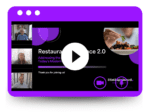The explosion of InsurTech continues to gain traction with more startups and new products being launched. Earlier this month, for example, Lloyd’s of London announced it is fast-tracking three startups to bring to market more quickly COVID-19 related products and innovations. InsurTech Lemonade announced it raised $319 million for its IPO; the company provides insurance for renters and homeowners in the U.S. for the stolen or damaged property as well as personal liability and recently announced pet health insurance as its latest offering.
When talking about InsurTech, a lot of jargon is bantered about, so we thought we’d give you a brief overview of the typical terms used in this area. Let’s first start with InsurTech, which refers to start-ups that use technology to transform and disrupt the traditional insurance model. Technology such as artificial intelligence and machine learning is utilized to create savings and cost efficiencies. Now let’s dig a bit deeper:
Artificial Intelligence (AI): Technology that enables computer systems to accomplish tasks that typically require a human’s intelligent behavior. For example, online interfaces and virtual claims adjusters make it more efficient to settle and pay claims following an accident, while simultaneously reducing the likelihood of fraud.
Big Data: Refers to a complex volume of data and the set of technologies that analyze and manage it. Big data can aid insurers’ underwriting, rating, marketing, and claim settlement practices. Telematics, for example, enables insurers to collect real-time driver behavior data and combine it with premium and loss data to provide discounts.
Blockchain: A blockchain is basically a record of digital events that is shared between different parties and can only be updated by consensus. The blockchain contains a certain and verifiable record of every single transaction. At InsurTech Lemonade, blockchain comes into play through smart contracts. The company’s business model takes a fixed fee from each monthly payment and allocates the remainder for future claims. If a claim is made, the blockchain’s smart contracts will immediately attempt to verify the loss so a customer can get paid quickly.
Customer Experience (CX): In incorporating artificial intelligence into claims, inquiries, and other policy service processes, insurers can deliver customer-centric strategies for more personalized, accurate information and streamline the customer experience. For example, an InsurTech company uses AI to provide new customers with tailored policies in just 90 seconds instead of 9 minutes.
Digital Footprint: As we navigate the Internet to work, communicate with family and friends, pay bills, buy stuff, and entertain ourselves, we leave a trail of clicks, taps, and swipes – our digital footprint – that collectively says something about us. Companies use our digital trails to learn about our behavior and preferences. This could help insurers in underwriting and rating policies.
Incubator: Provides business support to facilitate the successful development of startups and improve the potential for success by providing entrepreneurs with targeted resources and services – office space, professional services, and business advice, and access to a network of contacts. Lloyd’s Lab is an example of an incubator.
Internet of Things (IoT): Refers to the billions of physical devices around the world that are now connected to the Internet, all collecting and sharing data. Connecting these different objects and adding sensors to them adds a level of digital intelligence to devices, enabling them to communicate real-time data without involving a human being. For example, water damage is responsible for the majority of home insurance claims. Leak sensors deployed near potential accident areas such as water heaters and washing machines can raise alerts before a catastrophic event occurs.
Mobile: Mobile devices are where it all begins for InsurTechs, with value propositions that open and close through a mobile application – from policy purchasing to management and claims reporting and handling as well.
Peer to Peer (P2P): The P2P insurance model typically consists of a small group of family members, friends, or individuals with common interests who combine their premiums to insure against risks. When a loss occurs, money from the pool is used to cover the individual. Although this is not necessarily a new concept, P2P insurance leverages the shared economy and the latest technological advances in social networking.
These are just several of the most common terms used in today’s insurance tech world.





